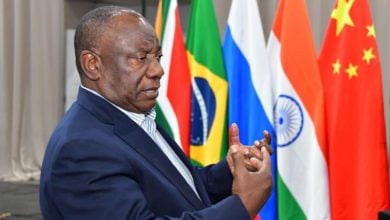What many revolutionaries around the world had projected was inevitable has now happened. The African National Congress’s “Tripartite Alliance” has split. In early November last year, the trade union confederation COSATU, which along with the Communist Party of South Africa and the ANC make up the alliance, expelled one of its largest and most radical-minded member unions, the National Union of Metalworkers of South Africa. After NUMSA’s expulsion by the Central Executive Committee of COSATU, seven other unions suspended their participation in the CEC.
These eight unions backed a call, originated by NUMSA, to convene a Special National Congress. At first, the Congress was called to deal with substantive political issues in the alliance, as well as internal questions such the 2013 suspension of COSATU General Secretary Zwelinzima Vavi, which many felt was a witch-hunt against a revolutionary-minded leader. A resolution adopted by the Special National Congress held Dec. 16-20, 2013, now calls for COSATU to break with the alliance and begin looking for an alternative.
This is a moment of great importance for revolutionary movements worldwide. Perhaps no set of revolutionaries has been as universally respected as those coming out of the ANC. However, their navigation of the post-Soviet era has drawn criticism from the left because of the detrimental adoption of large pieces of the neoliberal agenda prescribed by the Western imperialists for all countries.
The struggle inside the labor movement has become something of a proxy struggle between forces inside the ANC-led alliance regarding the direction of South Africa, and the contest has sharpened over time. In fact, the two sides no longer view themselves as contending wings of a broader revolutionary national liberation struggle but as sworn enemies.
Battle lines
On the one hand, the now also unofficially split South African Communist Party and elements of COSATU (some of whom are SACP members) charge that the NUMSA split is part of a “regime change” agenda, whereby—wittingly or not—splits in the ANC-led alliance are facilitating a plan by imperialism to short-circuit the liberation movement and the fight for socialism. On the other side, NUMSA and other sympathizers (as well as Julius Malema’s Economic Freedom Fighters) allege that the SACP has abandoned the struggle for socialism and that they and some other self-described revolutionaries and Marxists are in fact facilitating the deepening of a neo-liberal capitalist orientation in the ANC and for the country.
With the battle lines thus drawn, it is clear there is no going back. This is a struggle that has been bubbling under the surface since the 2007 Polokwane ANC policy conference, where it became clear that large sections of the socialist movement inside the ANC were unhappy with the strategic direction plotted by the alliance.
The basic capitalist trajectory of post-1994 South Africa has been well-documented. Currently over 50 percent of formal workers are living below the median wage, unemployment is a stunning 35.8 percent, and 13 million people suffer hunger on a daily basis. The basic trends are both undeniable and terrible. However, to suggest that the ANC is out-and-out neo-liberal is also an overstatement.
This perhaps owes something to the way “neo-liberalism” is thrown around as an ill-defined buzzword as opposed to a rigorous theoretical concept. Either way the actual post-1994 policy trajectory is more complex. Accepting that an immediate socialist transition was not on the agenda but at the same time seeking to improve the social status of working-class people, the ANC attempted to meld elements of the neo-liberal “Washington Consensus” with welfare state capitalism.
As many in the ANC repeatedly remind observers and commentators, there were notable post-1994 achievements, “including 3.3 million RDP [Reconstruction and Development Programme] houses built, 7 million more houses electrified, potable water to 92 percent of population (compared to 60 percent in 1994), NSF Aid to 1.4 million students, the post Polokwane HIV treatment rollout, and an increase of people receiving social grants from 3 to 16 million.” While this does indeed assure us that the ANC government contains comrades with good hearts, it ignores the basic point made by NUMSA and its co-thinkers in COSATU that the inchoate nature of these policies, embedded as they are in a strategy based on Washington Consensus-style policies, cannot seriously address the real needs of working people. The achievements pale in comparison with the growing poverty and deprivation brought about by adherence to the policy imperatives emanating from Washington, New York, London and Brussels.
That being said, there are elements of the SACP critique that deserve serious consideration—in particular, the party’s claim that a split in the ANC objectively favors imperialist hegemony worldwide. This is no idle charge being thrown at NUMSA. The Economist, for instance, welcomed the split. The editors see it as a healthy development for “South African democracy,” with the choices potentially available to voters (if NUMSA is able to launch a socialist party) more directly reflecting popular opinion, and therefore strengthening the faith of the masses in the democratic system.
The Economist article reinforces Lenin’s essential point that bourgeois democracy is the best of all possible “shells” for capitalism. The Economist has indeed been perspicacious as it concerns major shifts in South Africa. It also commented on the ascension of Thabo Mbeki to the presidency in 1999, predicting his likely inability to effectively consolidate the post-1994 capitalist consensus. Indeed, the ANC was forced to dismiss Mbeki as president before the end of his term because of the turmoil his policies caused.
As such, the SACP has deemed any splits (and by extension most criticism from the left) as part of a “regime-change agenda,” whereby the splits objectively strengthen the hand of international capital by weakening the ANC, which even though it has been responsive to capital has not, in the SACP’s estimation, been subservient to it. Weakening ANC hegemony over the political scene, then, ultimately weakens the ability to transcend capitalism, according to the SACP.
This argument has also extended to accusations and innuendo that certain individuals critiquing the alliance from the left are actual agents of imperialism.
This goes to the heart of the dispute, which turns on basic principles that cut across the revolutionary movement worldwide, in particular around the attitude towards the state.
The state and revolution
The South African Communist Party operates on an orientation that stresses “stages” of the National Democratic Revolution, and views the state as a strategic site of contestation. The essence of this policy, regardless of various pronouncements, is that the state, not the working class, is seen as the key element of transformation. That is, the revolutionary struggle requires a “developmental state” at this stage, which can create the “pre-conditions” of a socialist transformation. In other words, the existing capitalist state is not a block to socialist revolution but can facilitate the transition to socialism.
While at first blush this appears to be apostasy, it is worth noting that the idea of “top-down” revolutionary transformations has at least one historical antecedent. Italian revolutionary Antonio Gramsci in analyzing capitalist transitions in Italy and Germany noted that in these countries (as well as Japan and, in the estimation of the SACP, in South Africa via “South African Colonialism of a Special Type”) transitions from feudalism to capitalism took place from the “top down.” The ruling classes of those countries effected capitalist reforms and intermingled with rising bourgeois elements in order to avoid the fate that befell the ancien regime in France—a concept he referred to as “passive revolution.”
Those details here need not detain us. The broader point is that the SACP clearly believes the state can “change its spots” from capitalist to socialist without being replaced. This showed itself most criminally when the SACP did its best to excuse the Marikana massacre. Not only did the party defend the police—a key component of the state—it actually suggested that their actions were justified.
It seems undeniable that the SACP has abandoned the basic dictum written into the DNA of Marxists stated clearly in Marx’s Civil War in France: “the working class cannot simply lay hold of the ready-made state machinery, and wield it for its own purposes.”
It is of course this phrase that Lenin defended so succinctly in his polemic against the “yellow” Second International, The State and Revolution. It seems strange to have to state such basic facts when the SACP’s counsel has been of such great assistance to the working-class movement around the world. This is why despite the heated nature of the debate it is hard to reject the core of NUMSA’s position, which is that deployment in the capitalist state has eroded the revolutionary core of a once great party.
Party members have openly participated in putting forward government programs that attack the working class. The tongues and pens of the party’s very able Marxist theorists have been deployed to defend the most execrable policies. Now when presented with a clear political struggle, the party has done everything possible to muddy the waters with superfluous issues—accusing its opponents of being foreign agents on the one hand and on the other attempting to dress up NUMSA’s disagreements in a technical dispute over COSATU rules on raiding.
Further, in its initial statement on the National Development Policy, the SACP engaged in crass anti-Sovietism, deriding Soviet central planning and shockingly red-baiting NUMSA by ridiculing their more positive view. Even more, they go on in the same document to embrace a French-style Dirgisme. The comrades on the Central Committee would do well to revisit Comrade Fidel Castro’s memoirs, where he describes quite clearly the effect such policies had on the USSR when Gorbachev turned to Spanish social democrats to devise an economic program—and more notably that Cuba completely rejected the rubbish advice.
Equally false, the SACP has sought to label its opponents in the labor movement as “syndicalists.” This is absurd on its face given that NUMSA has proposed setting up a socialist party and COSATU has made no moves to set up any sort of political party acting independently as a workers’ vanguard.
That the SACP ultimately cannot acknowledge its own close attachment to the capitalist state has made many workers feel it is no real opposition to the offensives of the capitalists nor has it opened up space for new initiatives. How can workers have confidence in a party that defends the police, not the workers, when brutal cops shoot them down?
How can workers have any confidence in a party that routinely makes excuses for the capitalist excesses in state policy? Or for that matter whose members carry these policies out? The charge of syndicalism, like that of being agents of regime change, is clearly devised to prevent the true political issues from coming to light.
As NUMSA relates, COSATU noted at its Ninth Congress: “The Alliance is meant to achieve a minimum programme and, given its multi-class character and the associated limitations, the Alliance cannot be the vehicle to achieve an egalitarian society.”
This is ultimately the key issue. Is the state ultimately an instrument of class rule? The SACP clearly believes it is not, but simply a site for contestation. This seems remarkably ignorant of the history of our movement. Is it not entirely clear that from Chile in 1973, to Portugal in 1975, to Venezuela in our current day, just to name a few, that in fact when revolutionaries abandon Marx’s key dictum, that they cannot simply lay hold of the state machinery, they falter?
Is it made any clearer when we recite in the long list of revolutionary victories only nation-states where the revolutionary mass movements led by communists broke apart the oppressive state machinery?
Moving forward
If neither history nor Marxist-Leninist theory guides the prognostications of the SACP then what does? If their current policies are any guide, it seems to be an academically “correct” Marxism shorn of its revolutionary conclusions and divorced from revolutionary history. While the SACP can still mouth many of the phrases and present “analyses” that recognize some of the basic realities of class society, it cannot bring itself to draw the clear conclusions.
NUMSA has initiated two processes that clearly fill a necessary void. One is to establish a United Front, in line with the United Democratic Front of the 1980s, that can create unity between the struggles of workers on the job and the poor and unemployed in communities, and secondly, launching conversations about renewing the revolutionary socialist movement.
Splits in the workers’ movement are always regrettable but often inevitable and necessary. The SACP has clearly forfeited the independence of the working class to subordination to the political exigencies of a cross-class alliance. This is the essence of opportunism. For workers who seek to challenge capitalist exploitation but come up against the ANC government or its capitalist allies, it is necessary to seek political forms that allow them to wage their struggles effectively.
As it concerns regime change, it seems strange to lay this at the feet of NUMSA. In fact, the ANC itself has done as much as anyone to drive working-class political forces into the arms of the Democratic Alliance. By defending government policy at just about all turns, and rejecting an independent voice for workers, the door was opened for (criminally mistaken) leaders of township struggles, for instance, to seek aid and comfort from Helen Zille and her friends. It was the lashing together of unions with capitalist interests that allowed the anti-communist cancer in the workers’ movement, the Association of Mineworkers and Construction Union, to grow apace.
The reality is the growth of a base in the working class for a regime-change agenda to be located in precisely the fact that the Tripartite Alliance seems incapable of delivering, or even moving towards, a socialist regime change, which is the clear expectation raised by the Freedom Charter. The SACP refuses to even acknowledge that the ANC alliance involved monopoly capital, positing it as some force outside the government, an idea that does violence to the very core of Marxist theory—theory that the SACP cannot claim to be ignorant of.
Clearly, the need for a new socialist party is palpable. To delay a split for any longer in the hopes of an internal Alliance rapprochement can only open up more space that will be seized by right-wing and populist forces. The center of gravity of struggle against capital will shift to forces who actively oppose a transition to socialism. NUMSA’s initiatives represent hundreds of thousands of workers and have a truly revolutionary and internationalist spirit.
We in the Party for Socialism and Liberation had hoped for a rapprochement between the SACP and its opponents, but that prospect has grown more and more remote. While splits break unity, they often precipitate new alliances. We can only hope that the actions of NUMSA and the allied unions will draw the lines sharply and skillfully enough to facilitate a regroupment of truly revolutionary forces.






